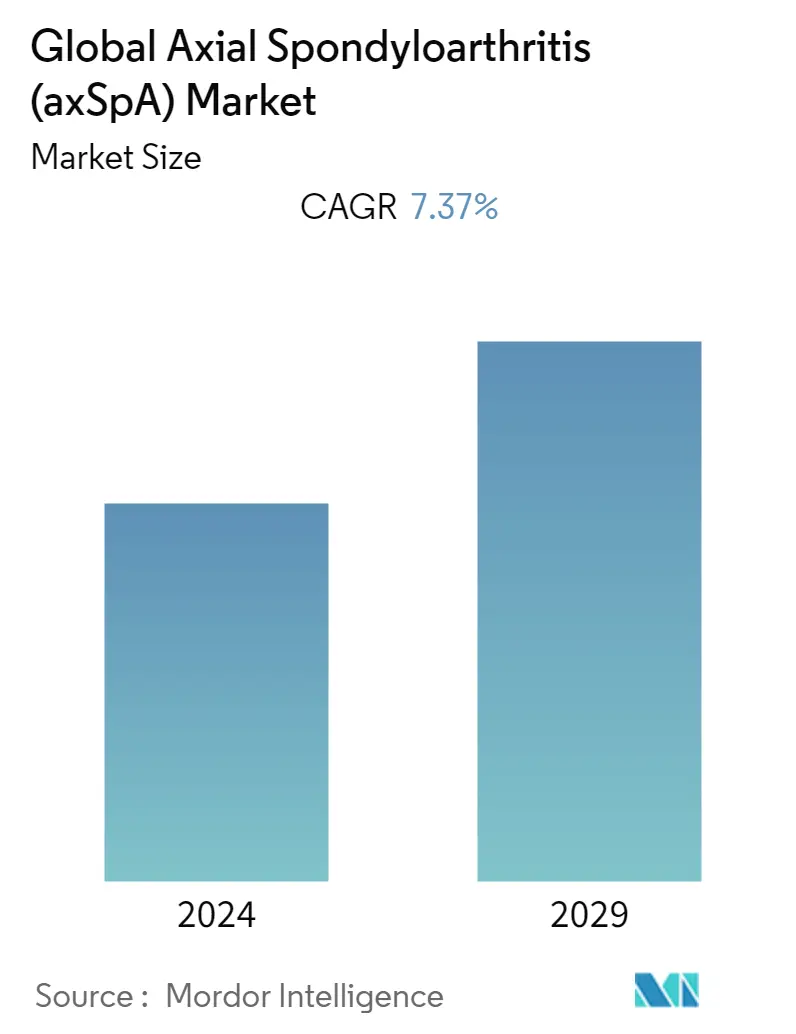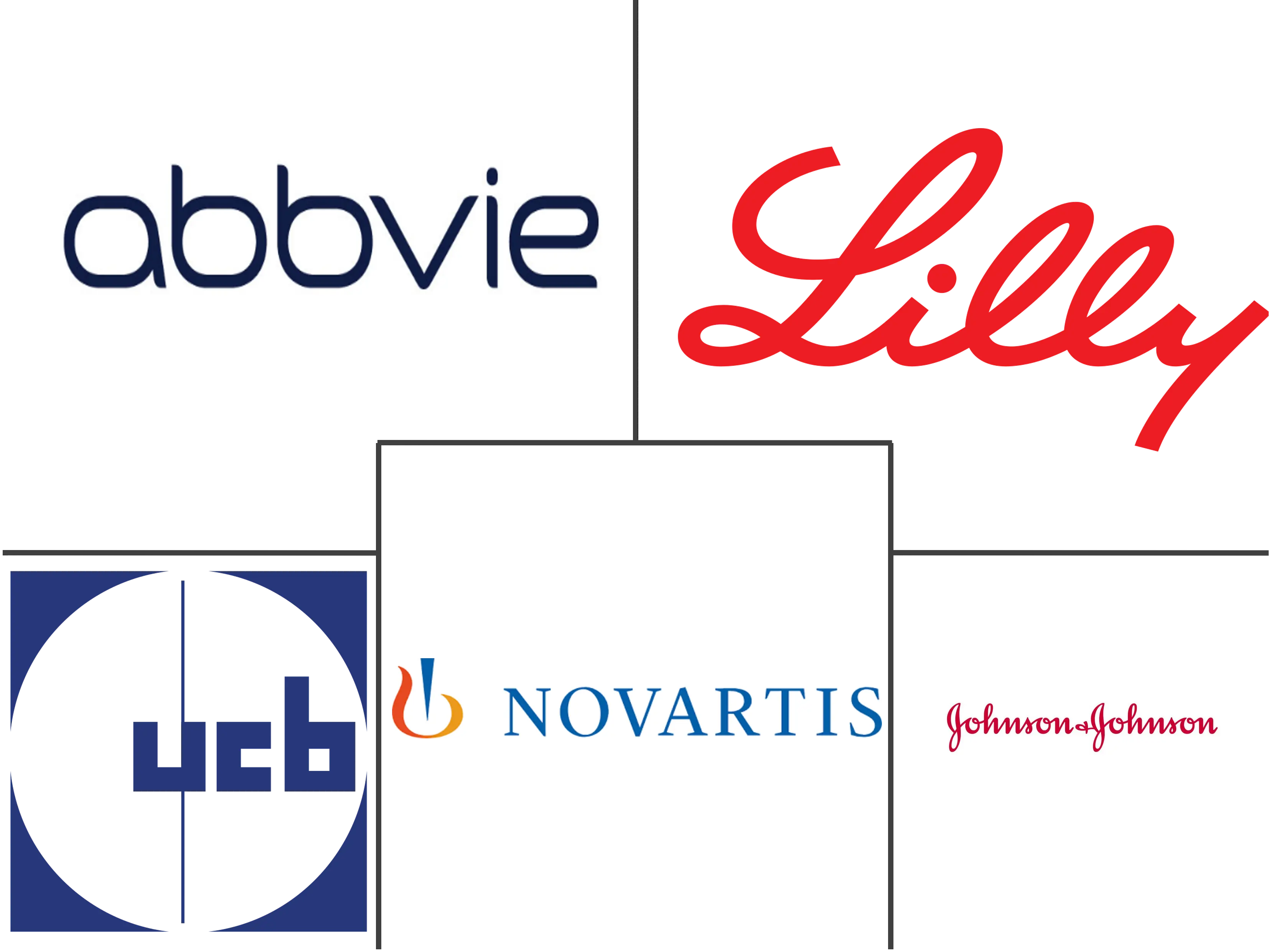Market Size of Global Axial Spondyloarthritis (axSpA) Industry

| Study Period | 2019 - 2029 |
| Base Year For Estimation | 2023 |
| Forecast Data Period | 2024 - 2029 |
| CAGR | 7.37 % |
| Fastest Growing Market | Asia-Pacific |
| Largest Market | North America |
Major Players
*Disclaimer: Major Players sorted in no particular order |
Need a report that reflects how COVID-19 has impacted this market and its growth?
Axial Spondyloarthritis (axSpA) Market Analysis
The Axial Spondyloarthritis market is projected to register a CAGR of 7.37% during the forecast period (2022-2027).
With the increasing COVID-19 cases worldwide, healthcare services diverted all resources toward patients suffering from COVID-19 disease. Although COVID-19 severely affects the respiratory system, it has created multiple uncertainties regarding rheumatic diseases or their treatment about the susceptibility to or severity of the viral disease. The COVID-19 pandemic has been especially challenging for patients with inflammatory diseases, including spondyloarthritis (SpA). Although numerous studies have addressed how a COVID-19 infection affects patients with rheumatic diseases, the conclusions from these reports have not been consistent. A study published in The Journal of Rheumatology in 2022 captured responses from 4723 subjects with SpA and 450 household contacts of these subjects showed that the COVID-19 pandemic created multiple uncertainties regarding rheumatic diseases or their treatment with regard to the susceptibility or severity of the viral disease.
There has been increased research and development going on for rheumatic diseases during the pandemic. For instance, in February 2021, EULAR, the European Alliance of Associations for Rheumatology, launched COVAX. This is a doctor-reported registry to collect information about COVID vaccination in people with both inflammatory and non-inflammatory rheumatic and musculoskeletal diseases (RMDs).
Certain factors that are driving the market growth include improvements in awareness which result in the increased patient pool that proves to be positive upfront for the Axial spondyloarthritis market and helps patients to try new interventions. There are several governmental and non-governmental organizations coming up to raise awareness among the general population about the condition. There are several initiatives taking place to advocate for people about the diagnosis and treatment of the same. Some of the initiatives include Rheumatoid Arthritis Awareness Day, supported by groups such as Arthritis National Research Foundation, which is held in February each year. In addition to this, Rheumatic Disease Awareness Month (RDAM) is held in September in the United States. As a result of increased awareness, people are aware of the diagnosis, and hence, the overall market will boost in the forecasted period.
Additionally, as part of the Bone and Joint Week celebration in October 2021, Novartis announced the renewal of its partnership with the Axial Spondyloarthritis Association of the Philippines (ASAPh) and Philippine Rheumatology Association (PRA) to raise awareness of Axial Spondyloarthritis (axSpA) early diagnosis and treatment.
The advent of biologic drugs has transformed the management of patients with axial spondyloarthritis. An increase in biologics is another factor that can drive the market. As per the American College of Rheumatology, Non-steroidal anti-inflammatory drugs (commonly called NSAIDs) offer symptom relief for most patients by reducing pain and swelling. Other medicines called biologics, including anti-TNF drugs (TNF blockers) and anti-IL-17 drugs (IL-17 blockers), are effective in patients who do not respond well enough to NSAIDs. The first lines of treatment are the NSAIDs, such as naproxen, ibuprofen, meloxicam, or indomethacin. Biologic medicines are manufactured within a living system, and target specific molecules believed to be involved in axial SpA. They are made up of genetically engineered proteins and are very large, complex molecules. The National Institute for Health and Care Excellence (NICE) has produced written national guidelines about prescribing anti-TNF therapy and anti-IL-17A that must be followed.
In addition to this, until very recently, there were five licensed anti-TNF drugs (adalimumab, certolizumab, etanercept, golimumab, and infliximab) for the indication of ankylosing spondylitis and four (adalimumab, etanercept, certolizumab, and golimumab) for the indication of Non-Radiographic Axial Spondyloarthritis (in the United States, only certolizumab was approved for the indication of Non-Radiographic Axial Spondyloarthritis). The IL-17 blocker secukinumab has been approved by both the European Medicines Agency (EMA) and the United States Food and Drug Administration (FDA) for the indication of ankylosing spondylitis. Ixekizumab was initially (2019) approved by the FDA for ankylosing spondylitis, and in July 2020, the FDA expanded the approval of ixekizumab to include Non-Radiographic Axial Spondyloarthritis; almost simultaneously, the EMA also approved ixekizumab for the treatment of both ankylosing spondylitis and Non-Radiographic Axial Spondyloarthritis.
Thus, owing to the abovementioned factors, the market is expected to show growth over the forecast period. However, severe adverse effects of certain therapeutic drugs significantly hinder the market's growth.
